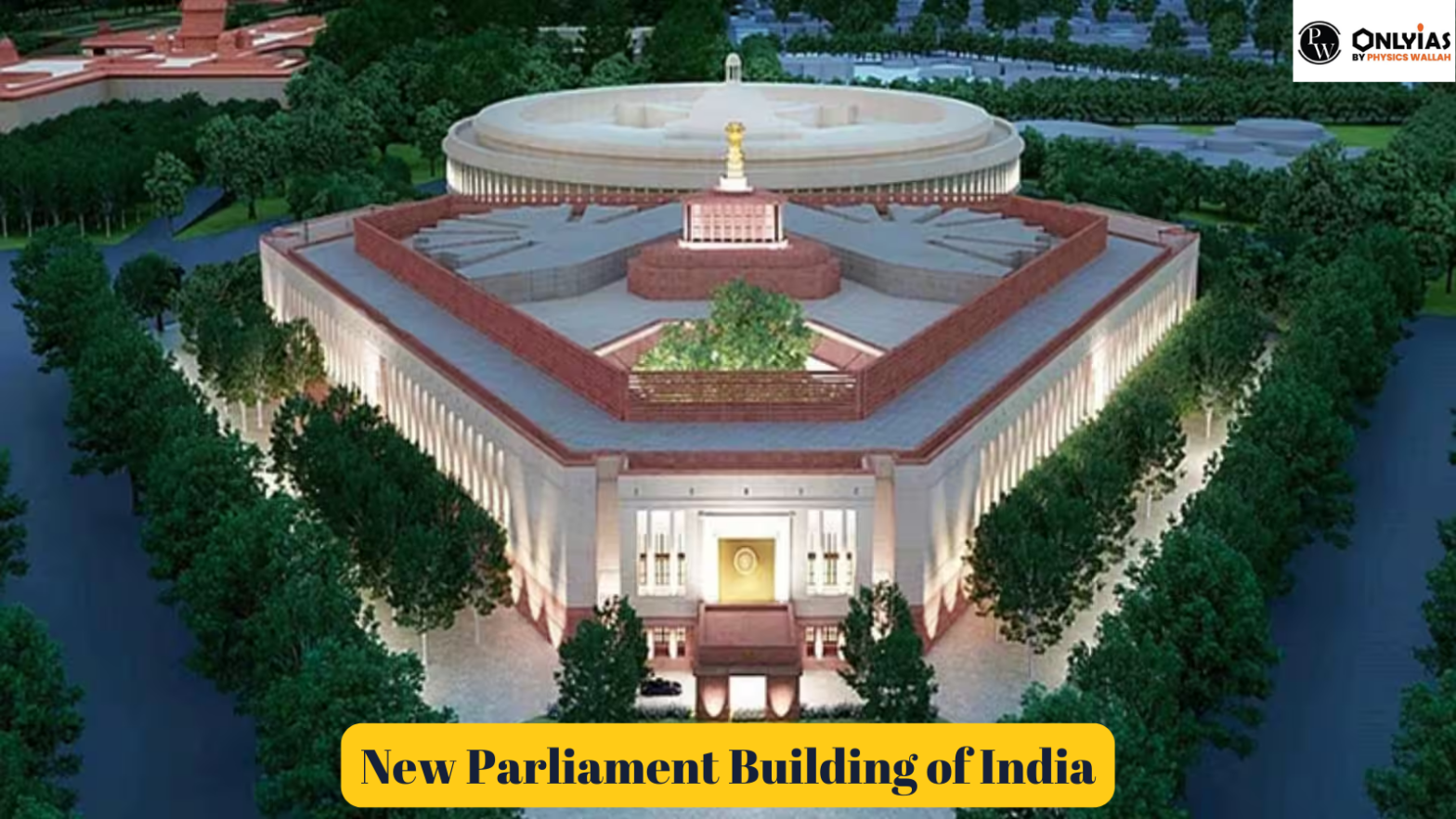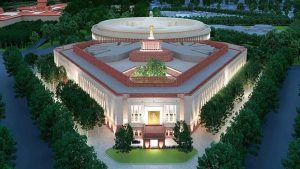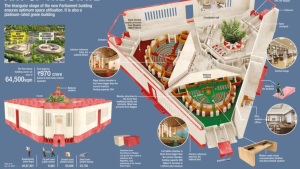The New Parliament Building is a topic of paramount importance, falling within the realm of the polity section of the UPSC subject matter, which holds a significant place in the UPSC syllabus. To learn more check out this article.

The upcoming New Parliament Building, set to be constructed by Tata Projects Ltd., will be situated adjacent to the current structure. This ambitious project is slated for completion within a span of 22 months, resulting in a building with a total floor area of 64,500 square meters, spread across four floors. What makes this endeavor even more remarkable is the collaborative effort of artists and sculptors from across the nation, showcasing the rich diversity of India and elevating it to the status of a symbol of “Atmanirbhar Bharat” or self-reliant India.

The New Parliament Building is a topic of paramount importance, falling within the realm of the polity section of the UPSC subject matter, which holds a significant place in the UPSC syllabus. Aspiring students can further enhance their preparation by opting for UPSC Mock Tests, which offer a valuable opportunity to sharpen their skills and accuracy in tackling this crucial subject.
The Sansad Bhavan, also known as the Parliament House in New Delhi, serves as the primary legislative institution for the Government of India. Within its hallowed halls, the Lok Sabha and the Rajya Sabha convene, representing the lower and upper houses, respectively, within India’s bicameral parliamentary system.
As part of India’s ambitious Central Vista Redevelopment Project, a brand-new parliament building has been meticulously constructed in New Delhi. This momentous structure was officially inaugurated on May 28, 2023, in a ceremony led by Prime Minister Narendra Modi.
The new parliament building is strategically situated on Rafi Marg, an artery that traverses the heart of the Central Vista. This prestigious location is surrounded by a constellation of iconic landmarks, including the Old Parliament House, Vijay Chowk, India Gate, National War Memorial, Vice President’s House, Hyderabad House, Secretariat Building, Prime Minister’s Office and residence, ministerial edifices, and various administrative units of the Indian government.
The New Parliament Building, a vital component of the Central Vista Project, stretches from Rashtrapati Bhavan to India Gate. This expansive project encompasses the Rajpath plots of land located in close proximity to North Block, South Block, the Parliament building, and various other secretariat structures for the central government.
The genesis of this monumental project traces back to December 1911 when King George V made a historic announcement during the Delhi Durbar, a grand assembly. At this momentous event, it was declared that Delhi would replace Calcutta as the capital of India. This proclamation was made in conjunction with the celebration of King George V’s coronation.
Also Check:
The responsibility of creating this new metropolis fell into the capable hands of two renowned architects: Edwin Lutyens, known for his steadfast commitment to European Classicism, and Herbert Baker, a celebrated architect from South Africa. Herbert Baker, notable for his design of the Union Buildings in Pretoria, South Africa, collaborated with Lutyens in crafting the design for Parliament House. The inspiration for the architecture of the Indian Parliament was drawn from the Chausath Yogini Mandir in Madhya Pradesh. Additionally, Edwin Lutyens took on the role of designing Rashtrapati Bhavan, while Herbert Baker was the mastermind behind The Secretariat, which includes both the North and South Blocks.
Sansad Bhavan, commonly referred to as the Parliament House, is the principal location for the Parliament of India, situated in New Delhi. This distinguished edifice is the official setting where both the Lok Sabha and the Rajya Sabha convene, constituting the lower and upper houses within India’s bicameral parliamentary structure.

This iconic symbol of India’s democracy was captured in all its grandeur on the historic occasion of its inauguration, which took place on May 28, 2023.
On the 28th of May, 2023, Prime Minister Narendra Modi presided over the official inauguration of India’s new parliament building. The day’s festivities commenced in the morning, with Prime Minister Modi unveiling a commemorative plaque, dedicating this architectural marvel to the nation, and addressing a gathering of esteemed lawmakers.
As a unique part of the inauguration ceremony, inspired by a Tamil tradition, Adheenam priests presented a splendid gold-plated scepter, known as the Sengol, to Prime Minister Modi. He, in turn, installed this significant symbol of authority near the Speaker of the Lok Sabha’s chair within the new Parliament building.
Notably, the event witnessed the absence of many opposition parties, who expressed their preference for the president to officiate the building’s opening rather than the prime minister. Furthermore, the ceremony included a Sarva Dharma (all-faith) prayer service, conducted by religious leaders, symbolizing unity and diversity.
The proposed New Parliament Building Plan aims to address the current and future spatial needs of the Parliament, Ministries, and Departments. It also endeavors to provide improved public amenities, parking facilities, and various other enhancements. This redevelopment project is primarily driven by concerns related to fire safety, acoustics, and the deteriorating condition of the existing century-old structure.
The timeline for this ambitious project is as follows: construction of the new Parliament building is expected to be completed by July 2022, followed by the establishment of a shared Central Secretariat by March 2024. Once the project concludes, it is anticipated that the strength of the parliament will increase from 545 MPs to accommodate 900 seats. Moreover, a key objective of this initiative is to elevate the beauty of the Central Vista, transforming it into a premier tourism destination.
The forthcoming parliament building will be adorned with the national anthem crowning its entrance. Its ceiling will be adorned with traditional-style carpeting and fresco paintings reminiscent of those gracing Rashtrapati Bhawan. To preserve the essence of the current parliament, sacred shlokas will adorn the interior walls. The primary building material will remain Dholpur stone, similar to the current structure, although red granite may replace red sandstone in certain interior areas. Construction will be carried out with meticulous care to minimize disruption and protect the environment.
The new Lok Sabha chamber in the Parliament House will accommodate 888 members, a significant increase from India’s current 543 Lok Sabha seats. Likewise, the Rajya Sabha, which currently comprises 245 seats, will have room for 384 members in the new Parliament House. When a joint assembly of both chambers is convened at the new Parliament House, the designated chamber will accommodate 1,272 individuals. In contrast, the current Centre Hall, where both Houses convene jointly, provides seating for only 430.
Anticipating a larger Parliament, the new Lok Sabha and Rajya Sabha chambers have been designed to accommodate more members (888 and 384 seats, respectively). It’s worth noting that a 25-year moratorium on altering the state-by-state seat distribution is set to expire in 2026.
The forthcoming New Parliament Building promises to be a captivating masterpiece. It will boast six entrances, each adorned with guardian statues representing auspicious animals, meticulously chosen for their significance in Indian culture, vaastu shastra, and their embodiment of attributes such as intelligence, victory, power, and prosperity. These auspicious animals carry affirmations promoting harmony and well-being.
The New Parliament Building will also house three ceremonial foyers, four galleries for each of the two Houses, six granite statues honoring individuals who contributed to the liberation movement and the creation of the Constitution, several Indian galleries, and a dedicated Constitution gallery.
The historical scepter known as ‘Sengol’ from Tamil Nadu, which symbolized the transfer of power from the British and was once displayed in a museum in Allahabad, found its new home in the New Parliament Building. Prime Minister Narendra Modi personally installed ‘Sengol’ on May 28, 2023.
The credit for designing the New Parliament House goes to Ahmedabad-based HCP Design, Planning, and Management, under the leadership of architect Bimal Patel. This stands in contrast to the colonial-era Parliament House, which was conceived by British architects Sir Edwin Lutyens and Herbert Baker.
The New Parliament Building is set to be a significant aspect of the “Atmanirbhar Bharat” (self-reliant India) initiative, with artisans and sculptors from across India contributing to showcase the nation’s rich cultural diversity. Additionally, it’s worth noting that the new Parliament building is designed to be earthquake-resistant, ensuring its resilience in the face of natural disasters. For those interested in more details regarding UPSC (Union Public Service Commission) and related topics, they can explore the official website of PWOnlyIAS Coaching.
The new structure incorporates an expanded Lok Sabha Hall, capable of accommodating a maximum of 888 seats, as well as an enlarged Rajya Sabha Hall with a capacity of up to 384 seats. This augmentation allows for joint sessions of Parliament to accommodate a total of 1,272 seats, fostering inclusivity and ensuring the efficacy of democratic proceedings.
As an integral component of the ambitious Central Vista Redevelopment Project in India, a brand-new parliament building has been meticulously erected in New Delhi. The momentous inauguration of this new parliament building took place on the 28th of May, 2023, with Prime Minister Narendra Modi presiding over the ceremony. Situated prominently on Sansad Marg, this parliamentary edifice intersects with the Central Vista area, adding to the significance of its location.
The recently inaugurated triangular Parliament building has been attributed to the design talents of the esteemed architect Bimal Hasmukh Patel, who is 64 years old.

<div class="new-fform">
</div>
